|
New book well researched
Bourbon was shared, Frankfort then became
an embattled capital as Union made its move
Reviewed by
By DR. PAUL ROMINGER
Bugle Staff Writer
James M. Prichard, “Embattled Capital: Frankfort Kentucky in the Civil War,” Frankfort Heritage Press, Frankfort, Ky. 2014, 296 pages, including Appendix A, a list of local Civil War soldiers at 68 pages, Appendix B: Kentucky’s African American Civil War memorial, and 26 pages of chapter notes.
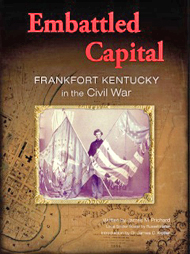 This is an interesting book. It is well written, with a style of composition that invites the reader to find a comfortable place to read and enjoy the story. The discussion of Frankfort’s economy as a part of the over-all Kentucky picture is excellent, especially given the size of the city. Whiskey, hemp, wool, cotton, pork and slaves formed the economic basis, linking Frankfort not only with Cincinnati and the North, but also with the South and Midwest by way of the Ohio and Mississippi Rivers and the railroads. This is an interesting book. It is well written, with a style of composition that invites the reader to find a comfortable place to read and enjoy the story. The discussion of Frankfort’s economy as a part of the over-all Kentucky picture is excellent, especially given the size of the city. Whiskey, hemp, wool, cotton, pork and slaves formed the economic basis, linking Frankfort not only with Cincinnati and the North, but also with the South and Midwest by way of the Ohio and Mississippi Rivers and the railroads.
The author, James Prichard, was Research Room Supervisor at the Kentucky Department of Libraries and Archives, and is currently in the Special Collections Department of the Filson Historical Society. The Frankfort Heritage Press is a nonprofit organization for charitable, literary and educational purposes, with a focus on Frankfort and Franklin County.
As the war began, Frankfort moved more into the Union camp. Confederate sympathizers resigned from state offices and headed south into Tennessee or went into hiding. Rumors were common that the Home Guard was in shambles and the capital was about to be invaded. Those who saved the city were quartered at the Court House, Masonic House and Capital Hotel.
Narratives of battles around the commonwealth and reactions in Frankfort to them are important. Many Kentuckians were saddened by the loss of relatives outside the state. Soldiers from Kentucky were at Shiloh in April of 1862, with a sizable loss of life. Many were captured, but by late summer and early fall, most prisoners from Kentucky had been exchanged.
While the account of the Battle of Richmond in August 1862, is quite brief, the author notes that the consequences of this decisive Confederate victory were crucial. Frankfort’s Home Guard Company Number One rallied at the capital’s court house. Gov. Robinson met with Maj. Gen. Wright in Frankfort and had been informed that the news from Richmond was very unfavorable.
On Sunday, Aug. 31, the day after the Battle of Richmond, the General Assembly voted to adjourn and reconvene in Louisville on Sept. 2. Frankfort fell quickly to Confederate cavalry under John Scott. In 1931, an eyewitness who was only 16 when the capital was taken, remembered that a young Louisiana lieutenant climbed to the top of the capitol building and, lacking a Confederate National Flag, hoisted a regimental cavalry guidon.
Kentucky’s Confederate governor, the elderly Richard Hawes, was inaugurated in Frankfort on Saturday, Oct. 14, 1862. As his inaugural address was drawing to a close, Confederate couriers rushed into Frankfort with news that a Union division was advancing on the capital. There was the distant sound of Federal artillery. Gov. Hawes concluded his speech, civil matters were ended and the actions of war returned.
Upon hearing the distant cannons, Humphrey Marshall at the side of his old friend, Orlando Brown, Sr., said to Brown, “There is our order to leave.” Brown responded, “I have a little good Old Bourbon at home. Go with me and try it before you go.” Marshall said, “I will go with you to your home and drink of your whiskey, and then I will go elsewhere. Here, I have been playing a part in a damned farce.”
At this point, it is hoped the reader is enticed find a copy of “Embattled Capital” and enjoy this narrative of Frankfort, its citizens and the commonwealth in the Civil War. It is a history skillfully researched and thoughtfully told.
|


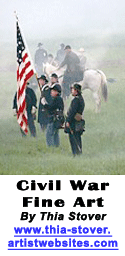
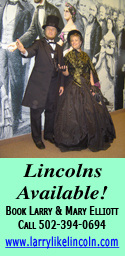

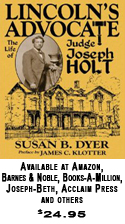
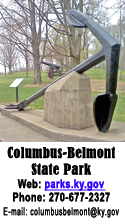



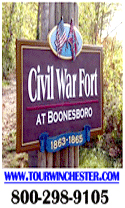
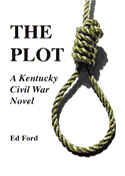


 This is an interesting book. It is well written, with a style of composition that invites the reader to find a comfortable place to read and enjoy the story. The discussion of Frankfort’s economy as a part of the over-all Kentucky picture is excellent, especially given the size of the city. Whiskey, hemp, wool, cotton, pork and slaves formed the economic basis, linking Frankfort not only with Cincinnati and the North, but also with the South and Midwest by way of the Ohio and Mississippi Rivers and the railroads.
This is an interesting book. It is well written, with a style of composition that invites the reader to find a comfortable place to read and enjoy the story. The discussion of Frankfort’s economy as a part of the over-all Kentucky picture is excellent, especially given the size of the city. Whiskey, hemp, wool, cotton, pork and slaves formed the economic basis, linking Frankfort not only with Cincinnati and the North, but also with the South and Midwest by way of the Ohio and Mississippi Rivers and the railroads.